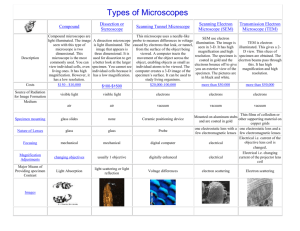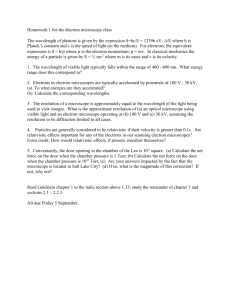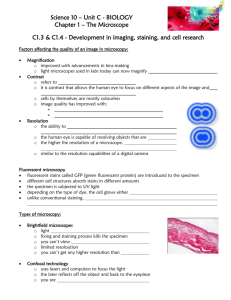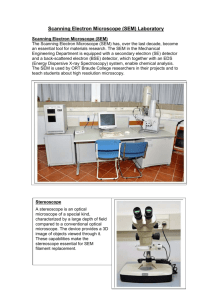Electron microscopy
advertisement
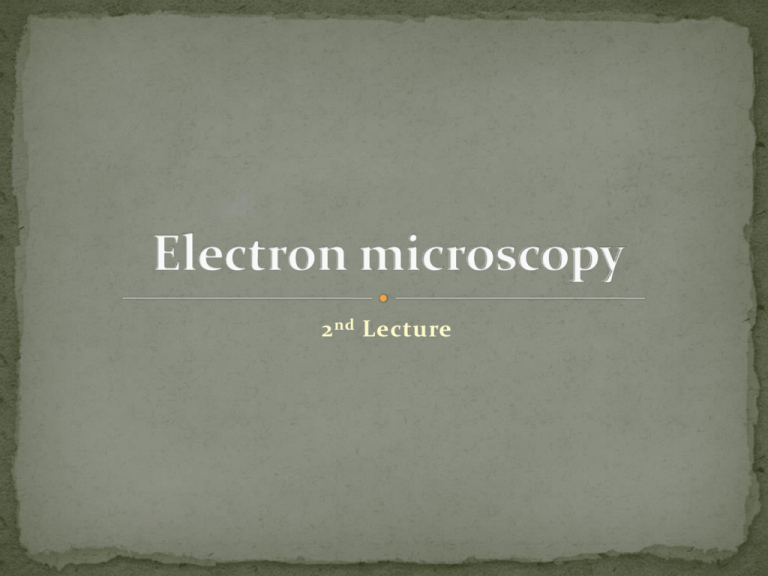
2 nd Lecture Scanning electron microscope The Key Components of a Scanning Electron Microscope Low-voltage electron microscope Comparision of light microscope and electron microscope: Principles of Microscopy: Wavelength Resolution Resolving Power (RP) Reflection Transmission Absorption Refraction Condenser As the electron beam copy the object, it interacts with the surface of the object, dislodging secondary electrons from the surface of the specimen in unique patterns. A secondary electron detector attracts those scattered electrons and, depending on the number of electrons that reach the detector, registers different levels of brightness on a monitor. Additional sensors detect backscattered electrons (electrons that reflect off the specimen's surface) and Xray (emitted from beneath the specimen's surface). Dot by dot, row by row, an image of the original object is scanned onto a monitor for viewing (hence the "scanning" part of the machine's name). Generally, the image resolution of an SEM is poorer than that of a TEM. However, because the SEM image relies on surface processes rather than transmission, it is able to image bulk samples up to many centimeters in size and (depending on instrument design and settings) can produce images that are good representations of the three-dimensional shape. Another advantage of SEM is its variety called environmental scanning electron microscope (ESEM) can produce images of sufficient quality and resolution with the samples being wet or contained in low vacuum or gas. This greatly facilitates imaging biological samples that are unstable in the high vacuum of conventional EM. The low-voltage electron microscope (LVEM) is a combination of SEM, TEM and STEM in one instrument, which operates at relatively low electron accelerating voltage of 5 kV. Low voltage reduces the specimen damage by the incident electrons and increases image contrast that is especially important for biological specimens. Electron gun: they produce the steady stream of electrons necessary for SEMs to operate. Lenses: they aren't made of glass. Instead, the lenses are made of magents capable of bending the path of electrons. By doing so, the lenses focus and control the electron beam, ensuring that the electrons end up precisely where they need to go. Sample chamber: The sample chamber of an SEM is where researchers place the specimen that they are examining. Because the specimen must be kept extremely still for the microscope to produce clear images. The sample chambers of an SEM do more than keep a specimen still. They also manipulate the specimen, placing it at different angles and moving it so that researchers don't have to constantly remount the object to take different images. Detectors: To detect the electron beam interacting with the sample object, Everhart-Thornley detectors register secondary electrons, which are electrons dislodged from the outer surface of a specimen. These detectors are capable of producing the most detailed images of an object's surface. Other detectors, such as backscattered electron detectors and X-ray detectors, can tell researchers about the composition of a substance. Vacuum chamber: SEMs require a vacuum to operate. Without a vacuum, the electron beam generated by the electron gun would encounter constant interference from air particles in the atmosphere. Wavelength: Length of a light ray; represented by the Greek letter lambda () Equal to the distance between two adjacent crests or troughs of a wave. The shorter the wavelength used, the greater the resolution that can be attained Resolution: Refers to the ability to see two items as separate and discrete units Resolving Power (RP) of a lens: is a numerical measure of the resolution that can be obtained with that lens. The smaller the distance between objects that can be distinguished, the greater the resolving power of the lens. Reflection: If the light strikes an object and bounces back (giving the object color). Transmission: The passage of light through an object Absorption: The light rays neither pass through nor bounce off an object but are taken up by the object Refraction: The bending of light as it passes from one medium to another of different density. Condenser: lens system located under the microscope stage that focuses light onto the specimen
